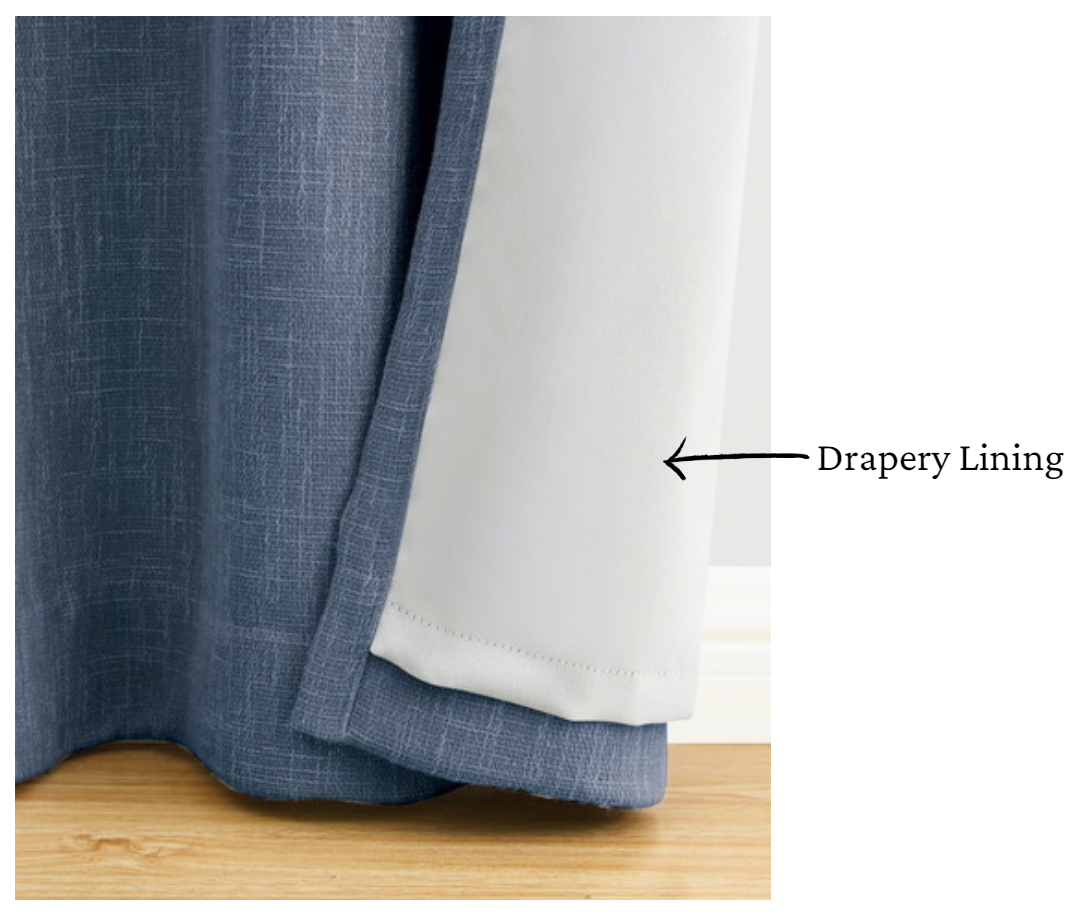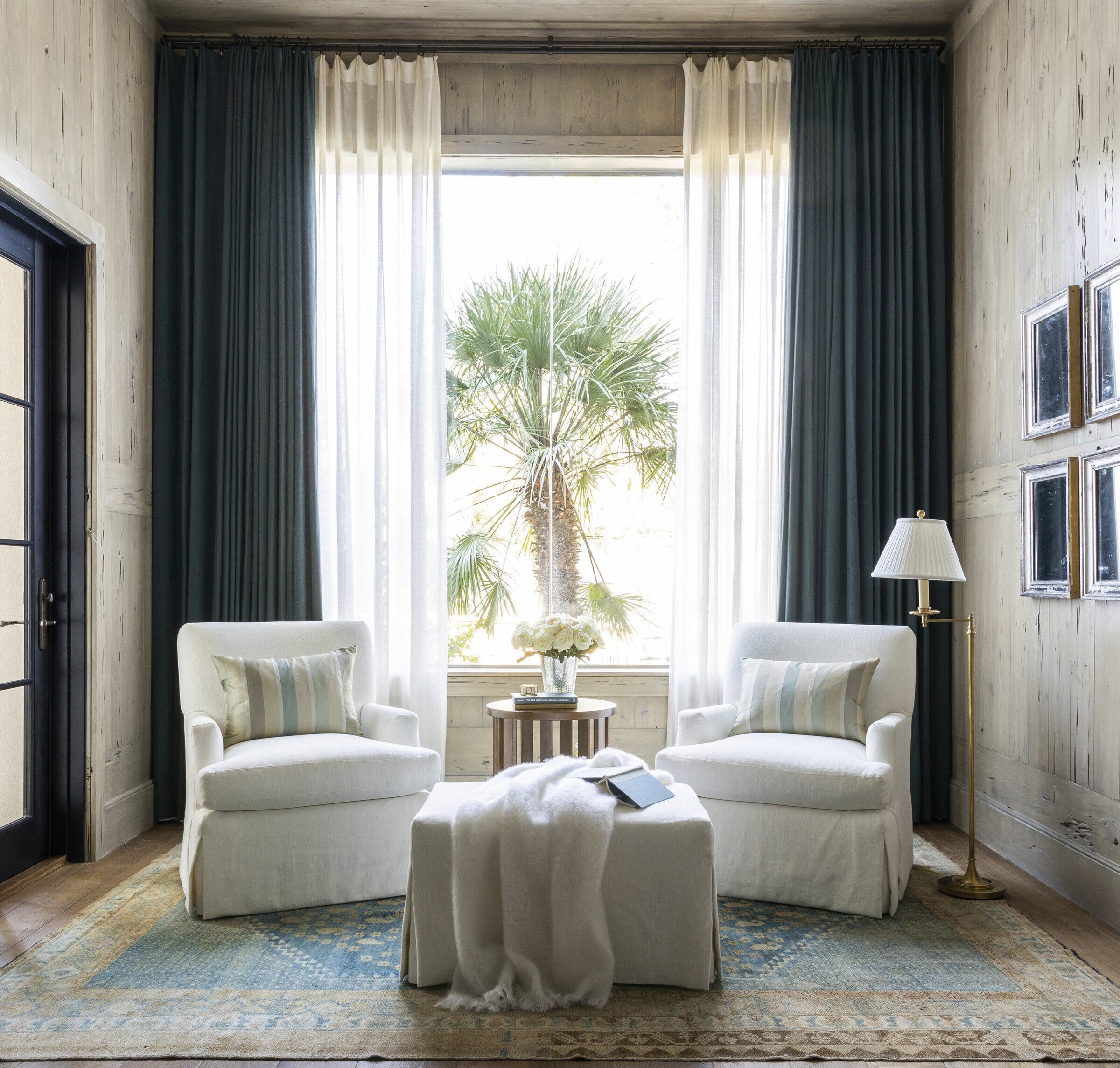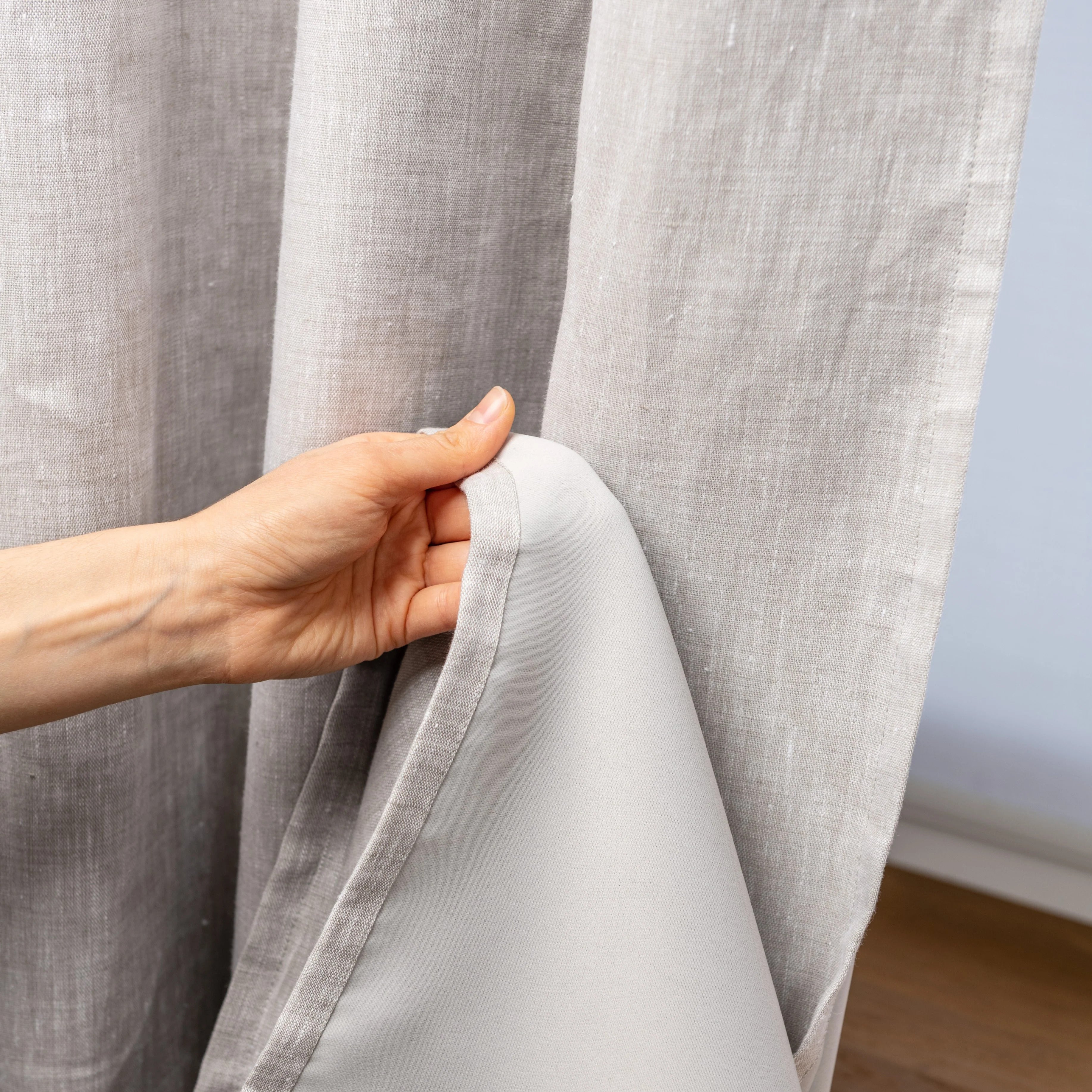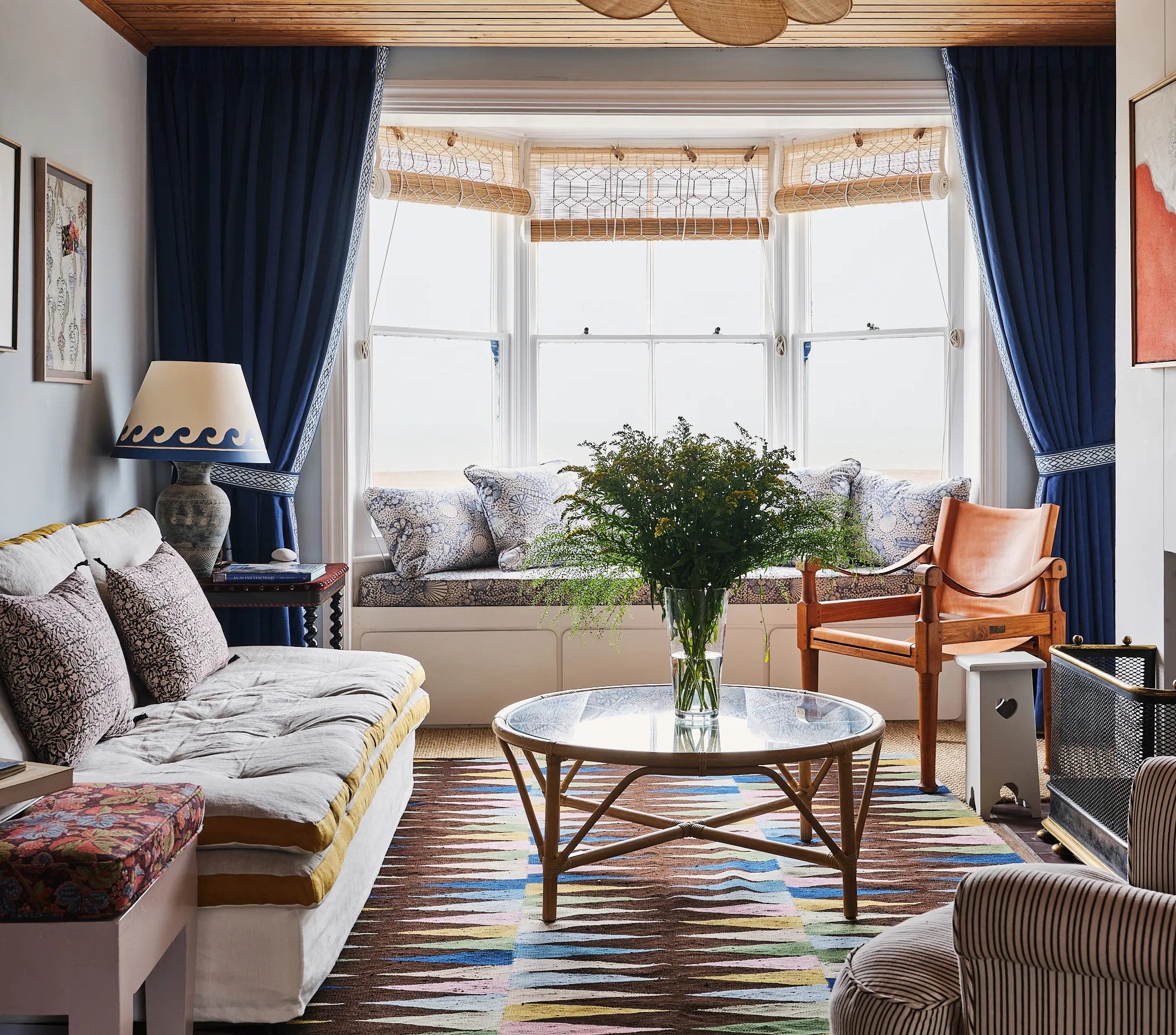Drapery Lining Options from The White Window

A significant part of our drapery shopping is dedicated to finding the perfect fabric that coordinates with our decor style and colour palette. But, something just as important, is the selection of lining for your curtains as the lining has a significant role to play in amplifying the visual appeal and functionality of the drapery.
Drapery lining refers to the added layer of fabric sewn to the back of the curtains to protect the face fabric from sun damage, increase the longevity of the drapes, and enhance the drapery’s insulative benefits.
Choosing the right lining for your custom curtains is a key decision as it impacts both the functional efficiency as well as the look of your drapes. But, how do you go about this selection? Well, our stylists are here to the rescue! From taking you through the benefits of lining to discussing the types of lining available at The White Window and how to choose between them, this blog attempts to rest all your queries and concerns.
What are the Benefits of Lining Curtains?

While drapery lining may seem like just another layer of fabric behind your curtains, it - in fact- shoulders the significant responsibility of enhancing both form and function. No wonder drapery stylists recommend adding lining to all curtains (except sheers of course), and here are all the reasons why:
LONGEVITY OF DRAPES: Drapery fabrics, particularly natural ones like cottons, silks and linens, are more prone to sun damage. Drapery lining can significantly enhance their longevity as well as that of other soft furnishings in the room, by providing an additional layer of protection against the sun and its harmful UV rays.
COLOR-FASTING: Color-fastness refers to the ability of the drapery fabrics to retain their original colour saturation over long periods. Adding drapery lining enhances the colour-fastness and prevents colour-fading, thereby preserving the vibrance and beauty of the curtains.
INSULATION: Being an ‘extra layer’ to your drapery fabric, curtain lining enhances the insulative properties of your drapes. It creates an additional thermal barrier that reduces heat transfer through windows, effectively regulating the indoor temperature and contributing to potential energy savings on both heating and cooling.
ENERGY SAVINGS & SUSTAINABILITY: Incorporating lining - especially blackout lining - can significantly reduce energy loss by up to 30%. Beyond the economic benefits, this energy efficiency aligns with sustainability goals, promoting eco-friendly practices and minimising the environmental impact associated with excessive energy consumption.
ENHANCED PRIVACY: Curtain lining adds to the opacity of your custom curtains, enhancing the privacy of your home. In rooms where privacy is a key concern - such as bedrooms, bathrooms & nurseries, lining allows the curtains to act as a more efficient visual barrier, preventing any interior shadows or silhouettes from being visible to those outside.
RICHER FACE FABRIC COLOUR: The colours of unlined curtains may look washed out when strong sunlight falls behind them. Drapery lining adds a layer behind the face fabric, making the drapery ‘more opaque’ and allowing for the true fabric colours to show and shine, without seeming washed out from sunglare. This, in turn, also enables patterns to show their distinct shapes and contrasts. Furthermore, the yellow warmth of the sunlight can affect how the fabric colours ‘read’ to the eye. A bright white panel may end up looking like warm ivory due to sunlight behind on a sunny afternoon. A thick lining - such as our blackout lining - can help minimise this colour distortion.
ADDS FULLNESS TO DRAPERY: Lining adds volume and fullness to the drapes. Since the lining is ‘adding’ to the weight of the drapes, it helps in faster setting of curtain pleats with a straight, gorgeous fall. To learn more about how to get the perfect pleats, read our detailed blog on drapery training.
SOUND INSULATION: Linings - especially blackout linings - tend to further absorb and dampen sound, reducing noise transmission between indoor and outdoor environments and contributing to a quieter, more acoustically controlled space.
What are the Different Types of Lining?
At The White Window, we offer two types of drapery linings:
PRIVACY LINING

Our privacy lining is a standard drapery-weight white polyester.
One of the primary functions of this kind of lining is to reduce the sun's harsh glare and protect the expensive face fabric. By incorporating this lining into your drapes, you can create a more comfortable and visually appealing environment by softening the harsh sunlight streaming into a room.
However, it's important to note that while privacy lining effectively cuts down the sun glare, it does not possess room-darkening capabilities beyond what any standard drapery-weight fabric can offer.
Clients prioritising both light control and sound insulation may find a better match in blackout lining.
BLACKOUT LINING

Our blackout lining is a specially coated, thick-woven fabric, produced specifically to block incoming light to a considerable degree. Since heat is associated with light, it also blocks heat transmission which is of great help during summer to keep the home’s interiors cool. In winter, it reduces energy spendings on your boiler and heating system as it reduces the loss of thermal energy through the windows considerably. The thick weave of the fabric also helps to muffle sounds, making your drapery capable of blocking out shrill external noises substantially. In short, blackout lining helps the drapery to block light, heat and sound substantially.
Choosing a blackout face fabric for your drapes can offer all these benefits of course, but finding a blackout fabric that perfectly suits your aesthetic and palette can often become a challenge as the choice spectrum is limited. And that’s when blackout lining comes to the rescue!
If there’s a non-blackout fabric that speaks to your style, it only takes blackout lining behind it to convert it into blackout drapery. And just like that, the choice spectrum widens to include the whole 2500+ strong drapery fabrics collection of The White Window.
And, knowing how good a well-insulated curtain is for a home exposed to extreme weather conditions, some clients even opt for a blackout lining behind their blackout drapery fabric. Because who doesn’t like a double dose of something so awesome!
Our blackout lining is available in two colour options:
- GREY: Recommended behind face fabrics featuring cool colours such as white, blue, grey, etc.
- BEIGE: Recommended behind face fabrics featuring warmer hues such as cream, beige, red, yellow, etc.
Before we move on, we must mention that although the blackout lining is quite effective at blocking light, it is not 100% light-blocking. During brightest hours, daylight may diffuse through the lining of curtains and be visible like a soft glow on the frontage. There also are other factors beyond just the lining itself that play a role in how well-contained light leaks can be. More from our drapery experts on this below:
How to Make the Most of the Blackout Lining

While you may think that once you choose blackout lining, it’s all done and dusted, that’s not really the case – there’s more to consider. Once you’ve added blackout lining to your drapes, there are a few more steps you can take to further enhance the effectiveness of the blackout lining.
Below are some key decisions that will support the cause:
BE WISE WITH THE HEADING STYLE: Curtain heading styles such as tie tops, grommet tops and tab tops feature holes and gaps that allow light to peek through the header. To maximise the performance of your blackout curtains, we recommend avoiding these styles, and instead opting for headings such as any of the pinch pleats, rod pockets, back tab tops and flat panel tops that feature no holes and gaps. To learn more about the heading styles on offer, refer to our detailed Curtain Heading Style Guide.
DRAPERY MEASUREMENT: To make the best out of the insulative and light-blocking properties of curtains with blackout lining, ensure you order curtain panels with sufficient ‘fullness factor’ i.e. the drapery width. The better the pleat density, the higher the insulative efficiency of the drapes. This simple thumb rule should guide your width measurements.
Again, when it comes to choosing the length for your curtains, going for floor length is always better than sill-length and cafe-length curtains where light leaks are inevitable from the bottom of the drapes.
For further guidance on this matter, refer to our detailed Curtain Measurement Guide.
DRAPERY POLE PLACEMENT: To minimise light leaks from the edges, extend your drapery pole at least 15 cm beyond each side of the window frame. Additionally, position the drapery pole 15-20 cm above the window trim to minimise light from seeping in from the top.
SEAL THE SIDE GAPS: Consider using the hook and eye hack to seal the gap on the sides of your curtains to avoid light leaks from the edges of the drapes. For more information with reference pictures, check out this blog post.
USE FRENCH RETURN DRAPERY POLES: While the hook and eye method is an easy hack to seal light leaks from the sides, if you have not yet installed hardware in your home, we recommend considering French return drapery rods that feature curved or angled ends, allowing drapes to meet the wall. This seals the gap between the wall and the pole, thereby eliminating light leaks from the edges.
EXPECT FACE FABRIC TO PLAY A ROLE: Blackout lining is capable of blocking light to a high degree by itself, but it works in tandem with the drapery fabric. Therefore, the degree of its effectiveness can vary slightly based on the colour and composition of the drapery fabric. For example, you may find that the blackout lining ‘seems’ to block light more efficiently when placed behind a darker face fabric, than when sewn behind a lighter-hued drapery fabric. Similarly, fabrics with denser weaves such as velvets and heavier cottons work better at blocking light with blackout lining than, say, a loose-woven linen, since thick drapery fabrics provide ‘additional support’ to the lining. So, if a thicker drapery fabric falls in line with your aesthetic, know that it is a plus point as your blackout lining will do a better job with its assistance.
SHOP NOW: CUSTOM VELVET DRAPES FROM THE WHITE WINDOW
How to Choose Between the Two Types of Linings

When deciding between the two types of linings, consider the specific needs of your space to make an informed choice.
For rooms where room darkening, sound insulation and acoustics are a priority - such as bedrooms, nurseries, media rooms and home offices - blackout lining is often the default choice. Its dense, chemically-coated composition not only blocks light effectively but also helps muffle external noise, creating a more tranquil environment. Similarly, if insulation against drafts and colds is a key concern, blackout lining remains a popular choice. The added thickness and insulative properties of blackout lining contribute to temperature control, making it ideal for windows in spaces where maintaining a comfortable temperature is crucial.
Conversely, consider areas like sunlit living rooms, where you want to enjoy ample daylight without compromising on privacy. Here, privacy lining will fit the bill. Likewise, in kitchens and laundry rooms, where a bright and airy atmosphere is desirable, privacy lining lets you maintain a welcoming environment while still affording a high degree of privacy. The same holds true for bathrooms, where you may want to create a spa-like ambience with abundant natural light while ensuring a discreet setting.
Lastly, do note that while sheer and semi-sheer fabrics can be lined to achieve certain benefits, the lining does take away from their translucence, airiness and breezy feel. Therefore, we advise clients to consider their personal preferences and priorities before specifying lining behind semi-sheer/ sheer curtains.
In Closing

Now that you know the importance of drapery lining and the nuances of the different types of lining offered at The White Window, we hope you’ll find it much easier to make your choice while ordering the drapes.
So, get on with the best bit of the experience - shopping! Enjoy retail therapy to the fullest and browse through our collection of over 2500 fabrics for curtains online. Find the one for your home-sweet-home and shop away!

